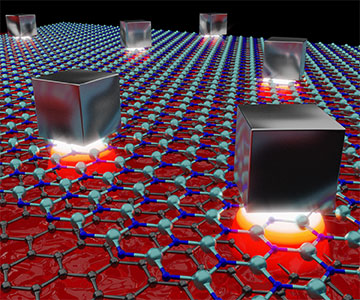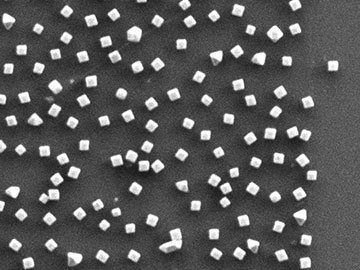
Artist’s impression: A collaboration of researchers from Europe and the U.S. has shown how to compress light beneath silver nanocubes positioned randomly on a graphene-based heterostructure. [Image: Matteo Ceccanti]
Plasmons have the remarkable property of being able to confine electromagnetic radiation to subwavelength spaces. They are potentially a boon for all sorts of applications, from sensing to telecommunications, and hold out the promise of shrinking optical technology down to the exceptionally small scales of modern integrated electronics.
The fact that plasmons have such short wavelengths makes their interaction with light a tricky business. But a group of scientists in Europe and the U.S. has now shown how it can be done, having confined infrared radiation on the nanometer scale by sprinkling silver nanocubes on graphene (Science, doi: 10.1126/science.abb1570).
Going nano
Plasmons can occur when electron oscillations at the surface of a metal couple with the electromagnetic oscillations of a nearby photon—the frequency of the two waves being the same. The resulting quasiparticles, known as surface plasmon-polaritons, can reduce the wavelength of light while increasing damping.
These particles have already been exploited in some applications. For example, the presence of certain biomolecules on a sensor can change the resonance conditions of the polaritons—resulting in the detection of the molecules in question.
However, plasmons could be put to far greater use if their ability to restrict electromagnetic waves to very small spaces can be harnessed. That is particularly true at infrared wavelengths, which are characteristic of many molecular resonances. The trick is to be able to probe conditions on the scale of nanometers or below, even though the probing radiation has a wavelength many hundreds or thousands of times greater.
Among the materials that can support plasmons is graphene, a semimetal hexagonal lattice of carbon just one atom thick. Electron oscillations within a sheet of graphene placed very close to a metal surface can generate plasmons with a very short wavelength—measuring just 1% of the equivalent electromagnetic wavelength in free space. To date, however, these “graphene plasmons” have not been confined to such small scales in all three dimensions, having been observed only over micrometer-sized areas.
Confining infrared light

A scanning electron-microscope image of the nanocubes on the graphene. [Image: Itai Epstein et al.]
To overcome this problem, Itai Epstein and colleagues at the Institute of Photonic Sciences (ICFO) in Barcelona, Spain, working with researchers in the U.S., France and Portugal, have exploited a phenomenon known as graphene plasmon magnetic resonance. This involved using far-field radiation to excite miniscule plasmon cavities over large swathes of graphene, without having to use lithographic etching or worry about matching the light’s polarization.
They did this by randomly positioning cubes of silver, each no more than 75 nanometers across, on a sheet of graphene capped by a layer of hexagonal boron nitride. They then placed this heterostructure on to a substrate made from silicon and silicon dioxide.
The researchers illuminated this structure with infrared light and measured the optical response. They found that when they varied the concentration of silver nanocubes but kept the size of those cubes fixed, the resulting spectrum remained constant but the amplitude changed. Not so when they used nanocubes of differing sizes, however. In that case, the spectrum did change.
Epstein and co-workers therefore conclude that it is the properties of the individual nanocubes that determine the device’s optical response. In other words, each nanocube traps the plasmon radiation between itself and the graphene layer—so acting as a single optical cavity. Indeed, computer simulations confirmed that an intense magnetic field is set up in the gap between the graphene and nanocube.
Chemical manipulation, sensing and more
The researchers found that their system can compress infrared light to a volume more than a billion times smaller than that of the equivalent free-space radiation. As such, they say, it could be used to study phenomena in which radiation couples very strongly with matter, such as certain types of chemical manipulation.
What’s more, they reckon that the cavities could also be exploited as tiny antennas, given that the spectral response can be tuned from the far infrared to the near infrared simply by varying the density of electrons in the graphene. Again, they established this using computer modeling, this time by simulating how each cavity scatters incoming radiation.
Before the scheme can be exploited outside the laboratory, however, Epstein says that he and his colleagues need to improve the graphene plasmons’ response by using higher quality materials. But once they do, says group leader Frank Koppens, ICFO, the system could “open a path” to a new generation of infrared molecular sensors.
